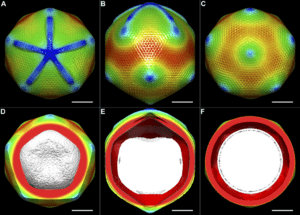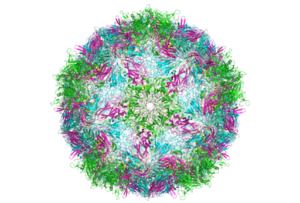RCH Achieves AWS Life Sciences Competency
Leading Cloud solutions exclusively for Life Sciences teams that accelerate discovery, optimize costs and ensure scalability and compliance in AWS.

The 2017 Nobel prize in chemistry marked a new era for scientific research. Three scientists earned the honor with their introduction of cryo-electron microscopy—an instrument that delivers high-resolution imagery of molecule structures. With a better view of nucleic acids, proteins, and other biomolecules, new doors have opened for scientists to discover and develop new medications.
However, implementing cryo-electron microscopy isn’t without its challenges. Most notably, the instrument captures very large datasets that require unique considerations in terms of where they’re stored and how they’re used. The level of complexity and the distinct challenges cryo-EM presents requires the support of a highly experienced Bio-IT partner, like RCH, who are actively supporting large and emerging organizations’ with their cryo-EM implementation and management. But let’s jump into the basics first.

Cryo-electron microscopy (cryo-EM) is revolutionizing biology and chemistry. Our customers are using it to analyze the structures of proteins and other biomolecules with a greater degree of accuracy and speed compared to other methods.
In the past, scientists have used X-ray diffraction to get high-resolution images of molecules. But in order to receive these images, the molecules first need to be crystallized. This poses two problems: many proteins won’t crystallize at all. And in those that do, the crystallization can often change the structure of the molecule, which means the imagery won’t be accurate.
Cryo-EM provides a better alternative because it doesn’t require crystallization. What’s more, scientists can gain a clearer view of how molecules move and interact with each other—something that’s extremely hard to do using crystallization.
Cryo-EM can also study larger proteins, complexes of molecules, and membrane-bound receptors. Using NMR to achieve the same results is challenging, as nuclear magnetic resonance (NMR) is typically limited to smaller proteins.
Because cryo-EM can give such detailed, accurate images of biomolecules, its use is being explored in the field of drug discovery and development. However, given its $5 million price tag and complex data outputs, it’s essential for labs considering cryo-EM to first have the proper infrastructure in place, including expert support, to avoid it becoming a sunken cost.
Introducing cryo-EM to your laboratory can bring excitement to your team and a wealth of potential to your organization. However, it’s not a decision to make lightly, nor is it one you should make without consultation with strategic vendors actively working in the cryo-EM space, like RCH
The biggest challenge labs face is the sheer amount of data they need to be prepared to manage. The instruments capture very large datasets that require ample storage, access controls, bandwidth, and the ability to organize and use the data.
The instruments themselves bear a high price tag, and adding the appropriate infrastructure increases that cost. The tools also require ongoing maintenance.
There’s also the consideration of upskilling your team to opera te and troubleshoot the cryo-EM equipment. Given the newness of the technology, most in-house teams simply don’t have all of the required skills to manage the multiple variables, nor are they likely to have much (or any) experience working on cryo-EM projects.
Biologists are no strangers to undergoing training, so consider this learning curve just a part of professional development. However, combined with learning how to operate the equipment AND make sense of the data you collect, it’s clear that the learning curve is quite steep. It may take more training and testing than the average implementation project to feel confident in using the equipment.
For these reasons and more, engaging a partner like RCH that can support your firm from the inception of its cryo-EM implementation ensures critical missteps are circumvented which ultimately creates more sustainable and future-proof workflows, discovery and outcomes.With the challenges properly addressed from the start, the promises that cryo-EM holds are worth the extra time and effort it takes to implement it.

As you consider your options for introducing Cryo-EM technology, one of your priorities should be to create an ecosystem in which cryo-EM can thrive in a cloud-first, compute forward approach. Setting the stage for success, and ensuring you are bringing the compute to the data from inception, can help you reap the most rewards and use your investment wisely.
Here are some of the top considerations for your infrastructure:
Implementing cryo-EM is an extensive and costly process, but laboratories can mitigate these and other challenges with the right guidance. It starts with knowing your options and taking all costs and possibilities into account.
Cryo-EM is the new frontier in drug discovery, and RCH Solutions is here to help you remain on the cutting edge of it. We provide tactical and strategic support in developing a cryo-EM infrastructure that will help you generate a return on investment.
Contact us today to learn more.
Sources:
https://www.ncbi.nlm.nih.gov/pmc/articles/PMC7096719/
https://www.nature.com/articles/d41586-020-00341-9
https://www.gatan.com/techniques/cryo-em
https://www.chemistryworld.com/news/explainer-what-is-cryo-electron-microscopy/3008091.article
https://www.ncbi.nlm.nih.gov/pmc/articles/PMC6067001/
Biotech and pharmaceutical laboratories are complex machines responsible for undertaking some of life’s most challenging problems.
Early drug discovery is an incredibly vast and complex discipline, and it demands research scientists use an equally vast and complex range of applications and technologies to achieve results. From purpose-built research equipment to specialty software, and cutting-edge research IT devices and architecture, today’s scientists rely on innovation more than ever to achieve tomorrow’s groundbreaking discoveries.
Usually, equipment manufacturers provide implementation and ongoing support to research laboratories that purchase their products. This is helpful when research scientists and data teams need to answer pertinent, narrow-scoped questions about set-up, service, and maintenance.
However, manufacturer support teams simply don’t have the scope or the resources to offer a holistic view of the laboratory itself. It’s not enough to get the equipment running properly – it must also run in the most efficient way possible, integrated with every other laboratory asset, in order to deliver the results you need. Successful research does not rely on any one device or process alone.
While manufacturer support teams play a vital technical role in helping Bio-IT teams deploy and integrate new technologies, they can’t play an advisory role that helps advance the lab’s overall drug discovery mission. This is true for a few reasons:
It Is Outside Their Scope. The core value that a manufacturer offers is just that – manufacturing. Every hour their support team might spend learning how your laboratory works and offering advice on how to improve its operations is an hour not spent delivering on their core value, which is developing and deploying the equipment they manufacture.
They Don’t Always Have the Expertise. While nobody contests the manufacturer’s technical expertise when it comes to their equipment, it’s unlikely that their support team has the knowledge needed to understand every single one of your lab’s drug discovery processes. Identifying optimal implementation simply isn’t possible without world-class, holistic expertise.
Data Bottlenecks Require Data-Driven Solutions. It makes sense to solve physical research bottlenecks with physical solutions – if DNA sequencing tasks are too slow, a new SMRT sequencer can solve the problem. But when data accessibility and integration are the culprits, you need to optimize your data infrastructure to produce results. New equipment won’t do.
Manufacturers Have a Predictable Bias. Ultimately, selling equipment is every manufacturers’ number-one priority. If you can improve research outcomes either by cheaply reorganizing your data infrastructure or by purchasing expensive new equipment, your manufacturer will recommend the expensive purchase first.
In a data-heavy field like early drug discovery, optimizing the way information flows throughout your laboratory is critical. Research computing is an essential part of the processes that enable new drug discoveries to make it to market, and successful implementation requires a highly specialized set of skills.
A reputable third-party research IT advisor or service provider can help your research and data teams solve file compatibility issues, optimize interdepartmental data-flow, and establish efficient porting and networking solutions. These can transform the way your lab communicates on a daily basis, making critical data available to the scientists who need it the moment they need it.
Partnering with a data-oriented research consultancy for Bio-IT teams can grant your laboratory access to objective equipment analyses. You no longer have to take manufacturers at their word – you can drive the value of every acquisition by getting a second opinion from an expert research consultant.
We are a team of professional biotech and pharmaceutical research experts dedicated to helping research labs optimize their approach to early drug discovery. We employ research application specialists, data scientists, and IT experts specifically to help research labs improve their research processes while spending less money.
Our specialized, service-based model treats the research laboratory as a holistic entity rather than the sum of various parts. This approach allows us to identify inefficiencies that manufacturer support teams often miss and to help researchers move closer to their goals. We help scientists choose the best tools for the job at hand and help them optimize the environment in which those tools are used.
RCH Solutions is a global provider of computational science expertise, helping Life Sciences and Healthcare firms of all sizes clear the path to discovery for nearly 30 years. If you’re interesting in learning how RCH can support your goals, get in touch with us here.